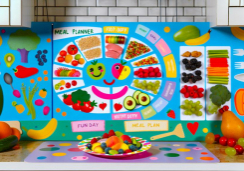Starting My Low-Carb Kitchen Journey: A Beginner's Guide
Have you ever considered how the contents of your pantry can directly influence your health and well-being? Embarking on a low-carb journey often begins with the fundamental step of transforming your kitchen into a haven for healthful choices.
As you stand on the brink of this lifestyle overhaul, you'll need to familiarize yourself with the strategies for purging high-carb temptations and restocking with essentials that align with your goals. It's not just about what you remove, but also what you add; this guide will provide you with a roadmap to navigate the aisles of your local grocery store, ensuring you're equipped with the knowledge to choose wisely.
You're poised to discover a trove of meal planning tips, recipe adaptations, and maintenance advice that will sustain your newfound low-carb way of life, all while fostering an environment conducive to success. But how, you might wonder, will you manage these changes without disrupting the dietary preferences and needs of others in your household? Stay tuned, as the art of balancing individual health goals with family dynamics is an essential chapter in your low-carb kitchen journey.
Assessing Your Pantry
Before embarking on your low-carb journey, it's crucial to assess your pantry and clear out high-carb and processed foods that could hinder your progress. As you start a low-carb or keto diet, the first step is to identify items that don't align with your goals. These typically include sugary snacks, bread, pasta, and other grain-based products. By removing these, you'll avoid temptation and make room for low carb foods that will form the basis of your meal planning.
To effectively follow a low-carb diet, you'll want to focus on consuming a certain number of net carbs per day. This involves tracking the grams of net carbs you eat, which is the total carbs minus fiber and sugar alcohols. Organize your pantry by placing these low carbohydrate options front and center. This way, when you're hungry, you'll reach for a keto meal instead of a high-carb snack.
If you're living with others who aren't following a low-carb diet, consider allocating a specific drawer or cabinet for high-carb items. This separation ensures that while you're reducing your intake, you're not imposing your dietary restrictions on the entire household.
Shopping for Low-Carb Staples
Once you've cleared your kitchen of high-carb temptations, it's time to stock up on low-carb staples that will sustain your new dietary lifestyle. When you hit the grocery store, focus on whole foods and ingredients that are low in carbs and align with low carb recipes. These will form the backbone of your meals, whether you're following a strict keto lifestyle or simply reducing your net carbs per day.
Here's a list of essentials to look for:
- Fresh vegetables: Opt for leafy greens, broccoli, and cauliflower.
- Quality proteins: Choose grass-fed meats, wild-caught fish, and free-range eggs.
- Healthy fats: Stock up on avocados, nuts, and olive oil.
- Dairy: Select high-fat options like cheese and full-fat Greek yogurt.
- Low carb products: Look for almond flour, coconut flour, and sweeteners like stevia or erythritol.
While shopping for low-carb staples, make sure to read labels carefully. Many products market themselves as 'low in carbohydrates,' but they can contain hidden sugars that could disrupt your carb diet. Educate yourself on the difference between total carbs and net carbs, and plan your grocery list to avoid impulse buys of high-carb foods.
Buying in bulk can also be a smart move to ensure you're always prepared with the right ingredients for your low-carb journey.
Planning Your Meals
Having stocked your pantry with low-carb essentials, it's crucial to map out your meals to maintain this healthier lifestyle effectively. Meal planning is a cornerstone of weight loss and management, especially on low carb diets. By knowing your daily net carbs per day, you can craft a meal plan that keeps you within your carbohydrate intake goals, potentially leading to a state called ketosis, where your body burns fat for fuel.
Start by including a variety of proteins, healthy fats, and low-carb vegetables to ensure nutritional balance. Pay attention to Nutrition Labels to calculate net carbohydrates, which is the total amount of carbs minus fiber and sugar alcohols. This number is key to staying on track.
To save time, consider batch cooking your Favorite Low Carb recipes. This approach means you'll always have a meal ready, preventing the temptation to reach for high-carb options. Use meal planning tools or apps to help organize your shopping lists and recipes.
Preparing Low-Carb Recipes
Embarking on the journey of preparing low-carb recipes requires an organized kitchen space that puts these healthier options at the forefront of your meal-making process. When you start this transition, it's crucial to focus on low carb or keto-friendly foods that will help you stay within your targeted net carbs per day.
Here's how you can prepare:
- Prioritize storage for low-carb foods, ensuring easy access to whole foods like vegetables, meats, eggs, and cheese.
- Calculate net carbs by subtracting fiber and sugar alcohols from total carbs to stay on track.
- Keep sugar-free alternatives handy to replace high-carb sweets and treats.
- Be mindful of hidden carbs in processed carb products, and opt for whole, unprocessed items.
- Respect the meal preferences of others in your household, finding a balance between low-carb and non-low-carb snacks.
Connect with the vibrant Low Carb and Keto community for support and recipe ideas. Thousands of subscribers are just an email or social media click away, ready to share their experiences and help you succeed.
Maintaining Your Low-Carb Lifestyle
To maintain your low-carb lifestyle effectively, start by purging your kitchen of high-carb and processed foods to minimize temptation and streamline your food choices. As a low carb beginner, it's crucial to understand that the first week can be challenging. You may experience side effects like the keto flu, which occurs as your body adjusts to burning fat instead of glucose for energy.
Keep net carbs per day within your target range, and ensure you're getting enough protein to sustain muscle health. A ketogenic diet isn't just about cutting carbs but also involves eating healthy fats and proteins. To manage this balance, rearrange your kitchen, placing items high in carbs in less accessible areas. Allocate a specific drawer or cabinet for these items, particularly if other household members aren't following a low-carb diet.
Consider designating a special spot for non-low carb snacks for the kids or other family members, ensuring they're out of sight and out of mind for you. Moreover, integrating Intermittent Fasting can complement your low-carb lifestyle by enhancing fat loss and metabolic health.
Frequently Asked Questions
How Do I Start a Low-Carb Diet for Beginners?
To start a low-carb diet, learn carb swapping basics, read labels carefully, and focus on meal planning with portion control. Use sugar alternatives, choose smart snacking options, and prioritize fats and hydration. Prep your kitchen accordingly.
What Can You Eat the First Week of a Low-Carb Diet?
In your first week, you'll eat protein-focused meals, choose healthy fats, and select low-carb veggies. Hydrate well, prepare snacks, and understand macros to manage cravings and tackle eating out challenges with carb swapping strategies.
What Is the Number 1 Carb to Avoid?
The number 1 carb to avoid is refined sugars, including sugar bombs like sweetened beverages, processed cereals, and high-fructose corn syrup found in many fruit juices and carb-rich snacks. Steer clear of these.
What Are the 5 Rules of Slow Carb?
You'll focus on protein, ditch white carbs, fill up on veggies, avoid sugary drinks, and plan a cheat day. This balances your glycemic index and insulin levels for effective carb cycling and portion control.
Conclusion
As you embrace your low-carb kitchen, remember the journey is a rewarding one. Keep assessing your pantry, restocking with essentials, and planning meals that align with your goals.
Experiment with recipes to keep your diet enjoyable and varied. Stay informed and connected with the low-carb community for support and inspiration.
By staying committed and adapting as needed, you'll find maintaining a low-carb lifestyle becomes second nature.
Here's to your health and success!










